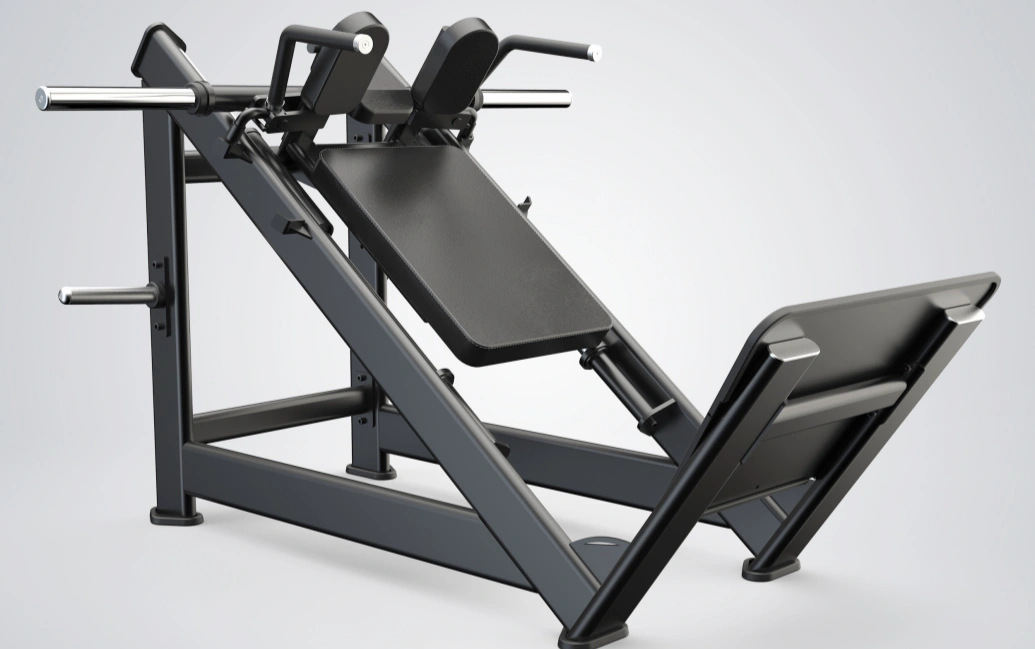
For a lot of lifters, the hack squat machine weight is more confusing than it looks.
It seems simple — load up some plates, push the sled, grow your quads.
But here’s the catch: you’re lifting more than just the plates you added.
The sled itself has weight.
Some machines add extra resistance through the frame or guide rails.
Others make it feel lighter at the bottom with a counterbalance system.
If you don’t know how that works, it’s easy to do too much, not enough — or end up with sore knees for no good reason.
This guide breaks it all down.
🟡 The hack squat machine starting weight is not zero.
Even with no weight plates loaded, you’re already lifting something — and often, it’s heavier than most people think.
🔍 So what exactly are you pushing before you even add plates? Let’s break it down:
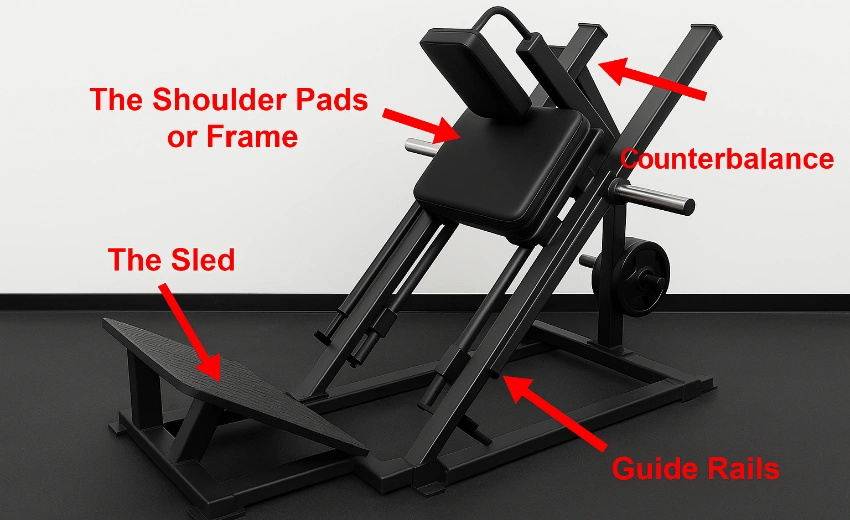
🔩 The Sled
This is the platform that moves up and down — the part you’re actually pushing with your legs.
Most sleds weigh somewhere between 75 to 125 lbs on their own, depending on the machine.
💡 In other words: even an “empty” hack squat already feels like a serious lift — because it is.
🏋️ The Shoulder Pads or Frame
Hack squat machines don’t use a regular barbell.
Instead, they’re built with shoulder pads or a fixed frame that adds another 20 to 30 lbs to the resistance.
You’re not balancing the weight, but your legs still have to move it.
The sled doesn’t just float — it slides on heavy-duty guide rails, which add friction and resistance.
⚖️ Counterbalance (If There Is One)
Some machines include a counterbalance system — like springs or pulleys — that slightly assist the lift by offsetting part of the sled’s weight.
🧠 Think of it like this: a spotter helping you through just the first few inches.
It doesn’t remove the resistance completely, but it makes the first push feel lighter.
Not every weight machine for squats has this — but if yours feels unusually smooth at the bottom, now you know why.
🧭 Step 1: Start with Control, Not Ego
Don’t load more weight than you can actually handle — just to look impressive.
A lot of people stack four or five plates on the hack squat, but barely move. They dip down an inch, then bounce right back up.
That’s not real training. What you want are clean, effective reps that actually build muscle.
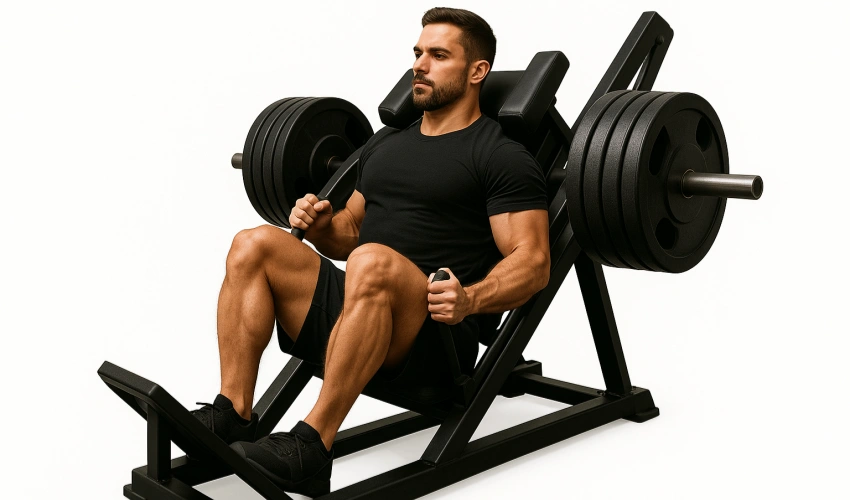
Not sure how much to start with? Here’s a simple guideline:
➡️ Begin light, focus on depth, balance, and control — then gradually add weight.
📊 Step 2: Know Where You Stand (Hack Squat Strength Standards)
Here’s how average lifters compare — based on real-world strength data.
These numbers include sled weight and assume proper form.
💪 Male Hack Squat Standards
| Level | Total Weight (lbs) |
|---|---|
| Beginner | 119 |
| Novice | 215 |
| Intermediate | 347 |
| Advanced | 510 |
| Elite | 694 |
💪 Female Hack Squat Standards (estimated)
| Level | Total Weight (lbs) |
|---|---|
| Beginner | ~65 |
| Novice | ~130 |
| Intermediate | ~210 |
| Advanced | ~305 |
| Elite | ~400 |
These aren’t hard rules, but they’re great reference points.
🎯 Step 3: Match the Weight to Your Goal
Don’t just copy the guy next to you. What you’re training for matters way more than how many plates are on the sled.
Here’s how to choose your weight based on what you actually want to achieve:
| Training Goal | How Heavy? (%1RM) | Reps Per Set | Focus |
|---|---|---|---|
| Muscle Growth | 70–85% | 8–12 reps | Build size (hypertrophy) |
| Strength | 85–95% | 3–6 reps | Lift heavier weight |
| Endurance | 50–70% | 12–20 reps | Push more volume |
| Rehab / Control | 30–50% | 10–15 slow reps | Work on range + control |
💬 Not sure what your “max” is?
Here’s a simple way to estimate it without testing it directly:
👉 Say you did 225 lbs for 8 good reps.
Use this quick formula:
Estimated 1RM ≈ 225 × (1 + 0.033 × 8) = about 284 lbs
This gives you a rough idea of what your max is — no need to risk injury testing it for real.
Let’s be honest — the hack squat looks scary if you’ve ever had knee pain.
Heavy weights, fixed track, deep range… it’s fair to ask:
🧠 “Will this mess up my knees?”
Short answer: Only if your form sucks.
The movement isn’t dangerous — the way people abuse it is.
Here’s what really causes knee pain on a hack squat, and how to stop doing dumb things that hurt.
❌ Mistake 1: Letting Your Knees Cave In——track to ligament stress
✔️ Fix it: Keep your knees in line with your toes. Not wider. Not inside. Just straight tracking.
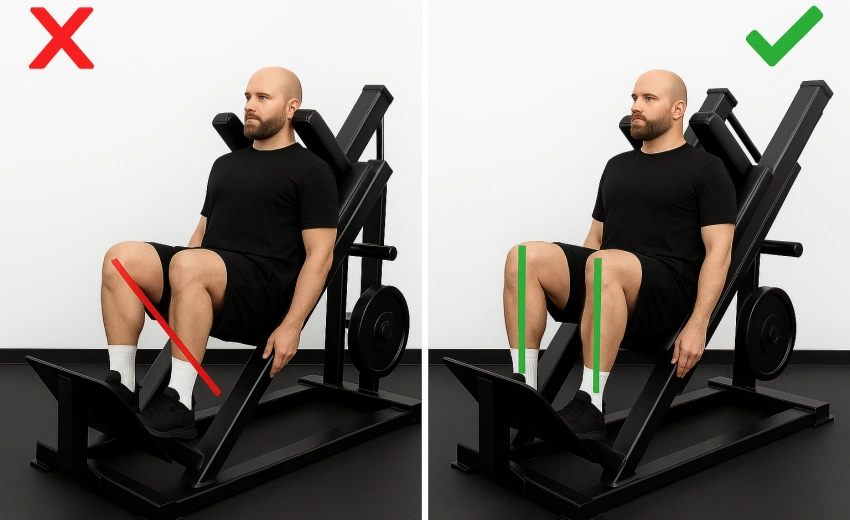
❌ Mistake 2: Feet in the Wrong Spot——Too high or Too low
✔️ Fix it: Mid-platform, shoulder-width stance, toes slightly turned out.
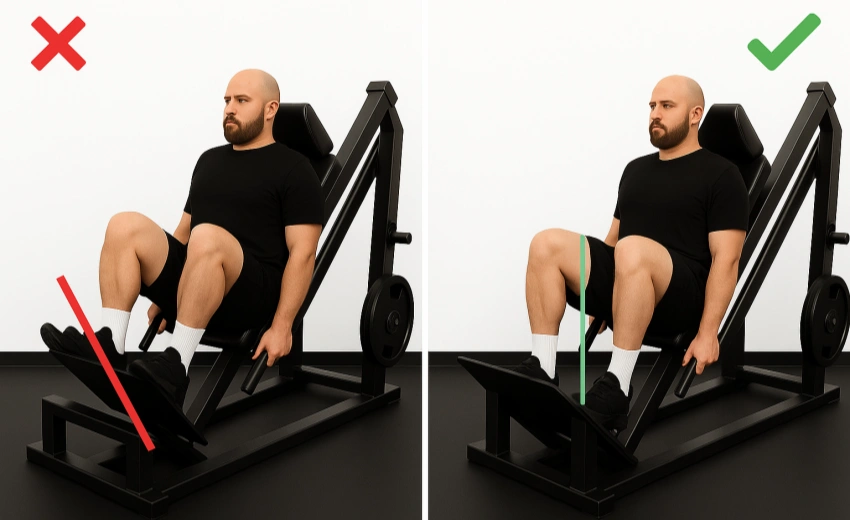
❌ Mistake 3: Lifting Too Heavy, Too Soon
If you can’t hit depth, your heels lift off, or you’re shaking halfway down — you’ve gone too heavy.
✔️ Fix it: Train your ego to sit the hell down. Start lighter. Earn your plates.
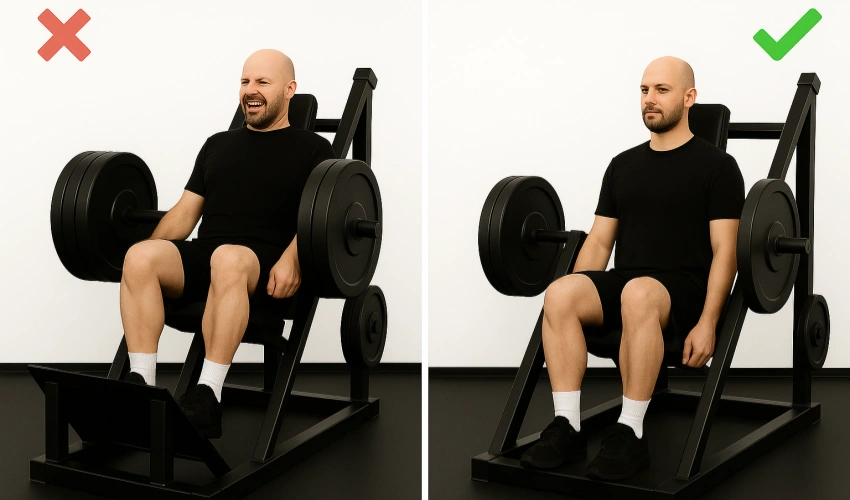
🛡️ Quick Tips to Keep Your Knees Happy
Even without any plates loaded, a hack squat machine isn’t light.
Most commercial models have a sled that weighs between 75 to 125 lbs. This is what you’re pushing every rep — even if the machine “looks empty.”
Some machines might feel a little lighter if they have a counterbalance system, but not by much. The resistance is still real.
If we’re talking about Smith machines, the bar usually weighs between 15 to 25 lbs because it’s on a guided rail and partially counterbalanced. On a hack squat or sled-style machine, the “bar” is usually part of the sled itself and doesn’t move independently.
The hack squat machine is a quad-dominant leg builder — plain and simple. It targets your quads, glutes, and hamstrings, while keeping your uppe
Here’s why it works:
Stability: You don’t have to balance a bar, so you can focus 100% on leg drive.
Quad isolation: The fixed path emphasizes your quads more than free-weight squats.
Progressive overload: It’s easier to stack plates and push heavier loads without risking your spine.
Lower back friendly: The angled sled supports your back and reduces spinal compression.
I’m Jessica Camp, a passionate fitness enthusiast and the creative force behind Inpek Fitness’s content. With over a decade in the fitness industry, I combine my expertise in exercise science with a deep knowledge of commercial gym equipment. I’m dedicated to promoting health and wellness by sharing valuable tips, training techniques, and the latest trends in Pin Loaded Machines, Plate Loaded Machines, Multi Function Gym Machines, Gym Multi, and Free Weights. Whether you’re a gym owner or a fitness enthusiast, my articles are crafted to inspire and empower you to reach your fitness goals. When I’m not writing, I love working out and exploring innovative fitness solutions.
Looking to enhance your gym with premium equipment? Have inquiries or ideas? Complete the form below to engage with our expert team. We’ll work with you to realize your fitness facility goals efficiently and effectively.